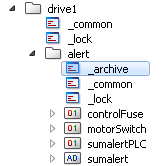_archive (Archiving)
In order to use values of data point elements for displaying history events in trend displays or reports, you must archive them.
-
Archiving saves the original value, source time and all status bits of a data point element. In addition, you can schedule smoothing for archived data.
-
The archive settings are stored in the attributes of the _archive config.
The names of config attributes and the related CTRL constants can be found in the Appendix.

Archive settings panel
DPE: displays the name (description or alias) of the data point element to be archived.
Active: The data is only archived if the Active check box is activated!
Smoothing: Activating Smoothing opens a selection list of smoothing types. Depending on the selected smoothing type, input boxes are displayed on the right. See chapter _smooth for the description and more details on smoothing!
You can select from 6 default archives in the combo box. The ValueArchive_0000 is used to archive internal data points.
The button Configure opens the panel to configure the History DB. NOTE that you have to configure the archives before assigning data points to the archives. See chapter Create and configure archives for more information.
If you assign the _archive config to a data point or a data point node, all elements under the data point or data point node will be archived. See the following screenshots.

The _archive config was added to the data point "drive1". This means that the whole data point including the "alert", "state" and "value" nodes are archived.

The _archive config was added to the data point node "alert". This means that the whole data point node "alert" is archived including all elements "controlFuse", "motorSwitch", "sumalertPLC" and "sumalert".

The _archive config was added to the data point element "ExampleDP_Arg1". Since the data point consists of only one element and an _archive config was added to that element, the whole data point is archived.



